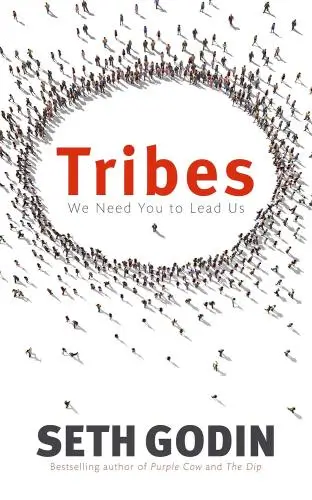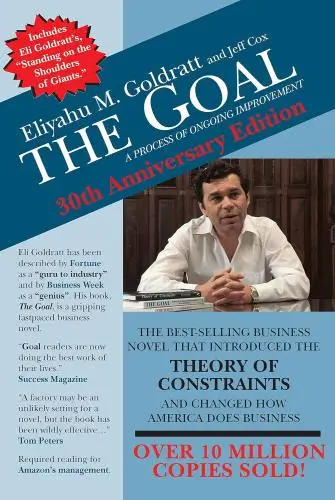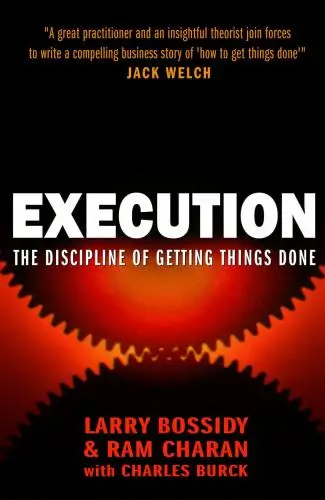
The 4 Disciplines of Execution
Achieving Your Wildly Important Goals
What is The 4 Disciplines of Execution about?
The 4 Disciplines of Execution is a guide to help your team fulfill its most significant objectives. This book introduces four essential principles: Focus on the Wildly Important, Act on the Lead Measures, Keep a Compelling Scoreboard, and Create a Cadence of Accountability. Through these disciplines, learn how to prioritize effectively, measure your progress, and maintain momentum in a team environment. Perfect for leaders and individuals alike, it offers a strategic approach to turning ambitious goals into reality.
About the Author
Chris McChesney, a mastermind of execution in the business world, co-authored "The 4 Disciplines of Execution," a transformative guide that empowers leaders to overcome the whirlwind of daily tasks and focus on strategic goals. McChesney's pragmatic approach, combined with real-world insights, turns the daunting into the doable, making his work a lighthouse for those navigating the rough seas of organizational change.
10 Key Ideas of The 4 Disciplines of Execution
Focus on the Wildly Important Goals (WIGs)
Concentrate your efforts on a limited number of goals that will make the most significant impact. Spreading resources too thin across many objectives dilutes focus and effectiveness. Identify what's absolutely crucial for success and channel your team's energy into achieving these few, vital goals. This approach ensures that everyone understands what's important and can direct their efforts where they will count the most.
Learn DeeperIdentify Your Wildly Important Goals (WIGs): Take a moment to reflect on your current objectives. Which of these goals, if achieved, would have the most significant impact on your life or work? Narrow them down to 2-3 WIGs to ensure your focus is laser-sharp.
Set Specific, Measurable Targets: For each WIG, define clear outcomes that can be measured. This could mean setting a specific revenue target for your business, losing a certain amount of weight, or finishing a project by a particular deadline. The key is to know exactly what success looks like.
Create a Plan of Action: Break down your WIGs into smaller, manageable tasks. What actions do you need to take weekly or daily to move closer to your goal? Schedule these tasks and treat them as non-negotiable appointments with yourself.
Track Your Progress: Regularly review your progress towards your WIGs. This could be a weekly check-in where you assess what's working, what's not, and adjust your strategy accordingly. Celebrate small wins to stay motivated.
Limit New Goals: While working towards your WIGs, be cautious about taking on new goals or projects. Ask yourself if they align with or distract from your current WIGs. If they're not aligned, it might be best to postpone or delegate them.
- Example
Example 1: A small business owner identifies increasing customer satisfaction as a WIG because it directly impacts repeat business and referrals. They decide to focus on improving response times to customer inquiries and personalizing the shopping experience. They set measurable targets for response times and track monthly improvements in customer feedback.
- Example
Example 2: An individual sets a WIG to improve their physical health by losing 20 pounds. They break this down into actionable steps like scheduling five workouts per week and planning healthy meals. They track their weight weekly and adjust their diet and exercise plan based on their progress.
Act on the Lead Measures
Identify and influence the lead measures that will drive success for your Wildly Important Goals. Lead measures are predictive and influenceable; they forecast the achievement of a goal before it happens and can be directly affected by your team's actions. Focusing on lead measures allows teams to exert influence over their goals' outcomes, providing a clear path to achieving them through specific, actionable steps.
Learn DeeperIdentify Your Wildly Important Goals (WIGs): Start by pinpointing 1-3 goals that are crucial for your success. These should be specific, measurable, achievable, relevant, and time-bound (SMART).
Determine Your Lead Measures: For each WIG, identify 2-4 lead measures. These are activities that will directly influence the achievement of your goals. Ask yourself, 'What actions can we take that will have the most impact on reaching our goals?'
Track Your Progress: Create a simple tracking system for your lead measures. This could be a spreadsheet or a dashboard where you can regularly record your progress. Make sure it's visible and accessible to everyone involved.
Hold Regular Accountability Meetings: Schedule weekly or bi-weekly meetings with your team to review progress on your lead measures. Discuss what's working, what's not, and adjust your strategies accordingly.
- Example
If your WIG is to increase customer satisfaction by 20% within six months, a lead measure could be the number of customer service training sessions completed by your team each month. By focusing on improving the quality of customer service through training, you're directly influencing customer satisfaction.
- Example
For a personal goal of losing 10 pounds in three months, a lead measure might be the number of calories consumed daily or the amount of exercise completed each week. By controlling these lead measures, you're directly affecting your ability to lose weight.
Keep a Compelling Scoreboard
Design a visual scoreboard that is simple, visible to all team members, and shows the progress towards the Wildly Important Goals. A compelling scoreboard creates a sense of competition that drives performance. It should clearly differentiate between lead and lag measures, showing at a glance whether you are winning or losing. This immediate feedback motivates the team and keeps everyone aligned and focused on the goals.
Learn DeeperIdentify Your Wildly Important Goals (WIGs): Start by pinpointing 1-3 goals that are crucial for your success. These should be specific, measurable, achievable, relevant, and time-bound (SMART).
Design Your Scoreboard: Make it simple yet visually appealing. Use colors, graphs, or charts to differentiate between lead measures (actions you can control) and lag measures (the results of those actions). Ensure it's accessible to all team members, either physically in a common area or digitally where everyone can see it.
Update Regularly: Keep the scoreboard current by updating it at least once a week. This keeps the team informed about their progress and maintains momentum towards achieving the WIGs.
Review and Discuss: Schedule regular meetings to review the scoreboard, discuss what's working, and address challenges. Use this time to celebrate wins, however small, to keep the team motivated.
- Example
A sales team aiming to increase quarterly sales by 20% could use a digital dashboard visible to all team members, showing weekly sales figures (lead measure) against the quarterly goal (lag measure).
- Example
A health and wellness group focused on losing weight might create a shared spreadsheet where members log their weekly exercise hours (lead measure) and track their weight loss progress (lag measure), with a visual chart to illustrate everyone's progress towards the group goal.
Create a Cadence of Accountability
Establish regular check-ins to ensure the team remains focused on the Wildly Important Goals and progresses on lead measures. These meetings should be short, focused, and action-oriented, allowing team members to report on their commitments, review the scoreboard, and plan for the next cycle. This rhythm of accountability fosters transparency, encourages commitment, and helps identify and overcome obstacles quickly.
Learn DeeperSchedule Regular Team Meetings: Set a recurring time each week for your team to come together. This could be every Monday morning or Friday afternoon, depending on what works best for everyone. The key is consistency.
Keep Meetings Short and Focused: Aim for 30 minutes or less. Start by having each team member report on their commitments from the last meeting, discuss the progress on the scoreboard, and then plan their next actions.
Prepare a Visual Scoreboard: Create a simple, visual representation of your team's progress towards the Wildly Important Goals. This could be a chart, graph, or any format that everyone can understand at a glance.
Encourage Open Discussion: Allow team members to share challenges and seek advice from the group. This fosters a supportive environment where obstacles are addressed promptly.
Follow Up Individually: If a team member is struggling with their commitments, schedule a one-on-one meeting to understand how you can help. This shows support and keeps the individual accountable.
- Example
A sales team sets a Wildly Important Goal to increase quarterly sales by 20%. They meet every Friday to review individual and team sales figures against their target, discuss strategies that are working, and adjust tactics for the following week.
- Example
A software development team working on a new product feature commits to weekly check-ins. During these sessions, they review the number of completed tasks versus what was planned, identify any blockers, and reassign resources as needed to stay on track.
Deeper knowledge. Personal growth. Unlocked.
Unlock this book's key ideas and 100+ more. Learn with quick, impactful summaries.
Read Full SummarySign up and read for free!
The 4 Disciplines of Execution Summary: Common Questions
Experience Personalized Book Summaries, Today!
Discover a new way to gain knowledge, and save time.
Sign up for our 7-day trial now.
No Credit Card Needed

Similar Books

The Founder's Dilemmas
Noam Wasserman
Traction
Gino Wickman
Tribes
Seth Godin
Management 3.0
Jurgen Appelo
The Goal
Eliyahu M Goldratt
Only the Paranoid Survive
Andrew S. Grove
Execution
Larry Bossidy
Reinventing Organizations
Frederic Laloux
The Ideal Team Player
Patrick M. Lencioni
Multipliers
Liz Wiseman
Team of Teams
General Stanley McChrystal
The Toyota Way
Jeffrey LikerTrending Summaries

Peak
Anders Ericsson
Never Split the Difference
Chris Voss
Smart Brevity
Jim VandeHei
The Psychology of Money
Morgan Housel
The First 90 Days
Michael D. Watkins
Atomic Habits
James Clear
The Body Keeps the Score
Bessel van der Kolk M.D.
Thinking, Fast and Slow
Daniel Kahneman
The Power of Regret
Daniel H. Pink
The Compound Effect
Darren Hardy
How to Win Friends & Influence People
Dale Carnegie
Eat That Frog!
Brian Tracy
The Magic of Thinking Big
David J. Schwartz
Drive
Daniel H. Pink
Essentialism
Greg McKeownNew Books

The Millionaire Fastlane
MJ DeMarco
Losing My Virginity
Richard Branson
Venture Deals
Brad Feld
48 Days to the Work You Love
Dan Miller
Anything You Want
Derek Sivers
Running Lean
Ash Maurya
Blitzscaling
Reid Hoffman
The Founder's Dilemmas
Noam Wasserman
Founders at Work
Jessica Livingston
The Startup Owner's Manual
Steve Blank
The Art of the Start 2.0
Guy Kawasaki
The Four Steps to the Epiphany
Steve Blank
Flash Boys
Michael Lewis
Crush It!
Gary Vaynerchuk
